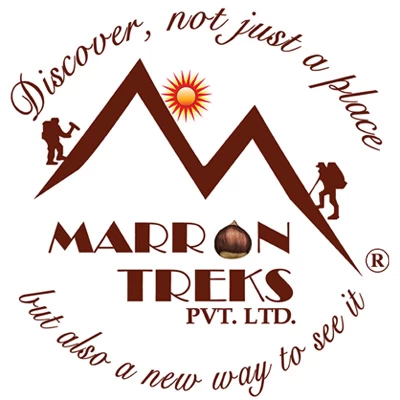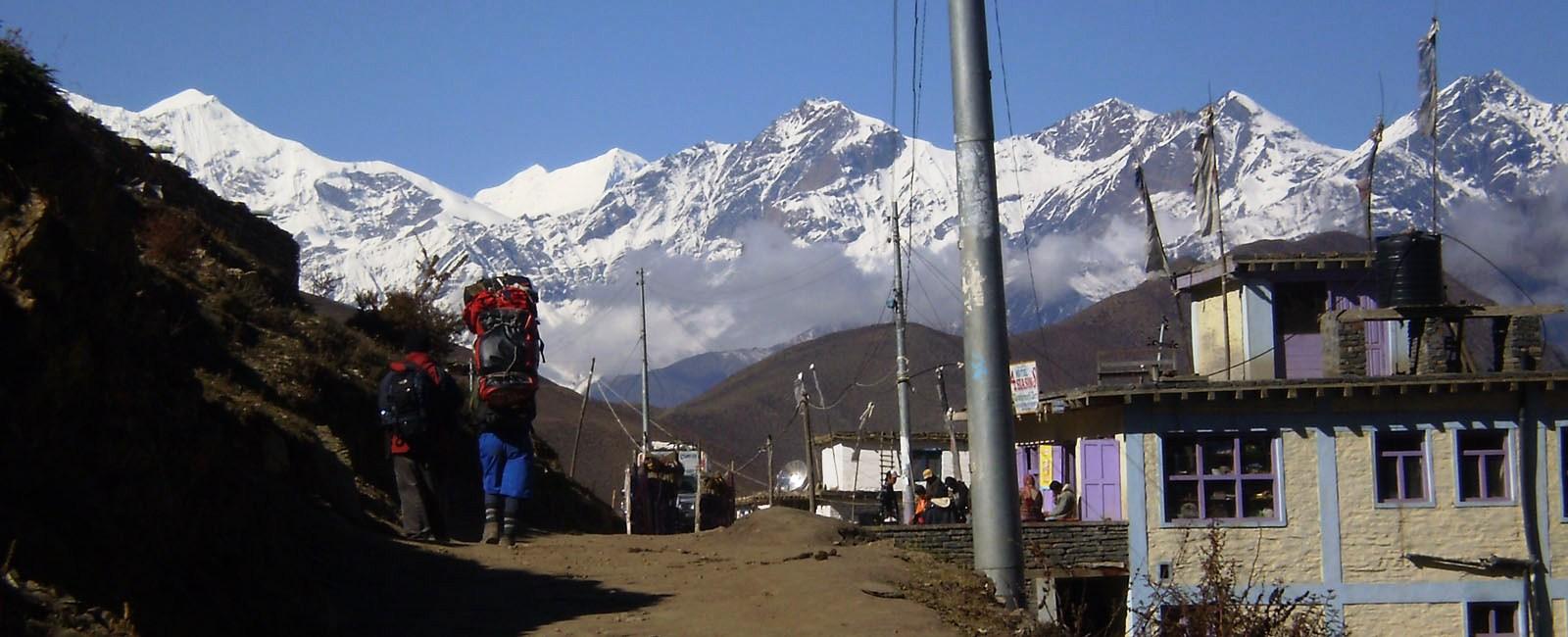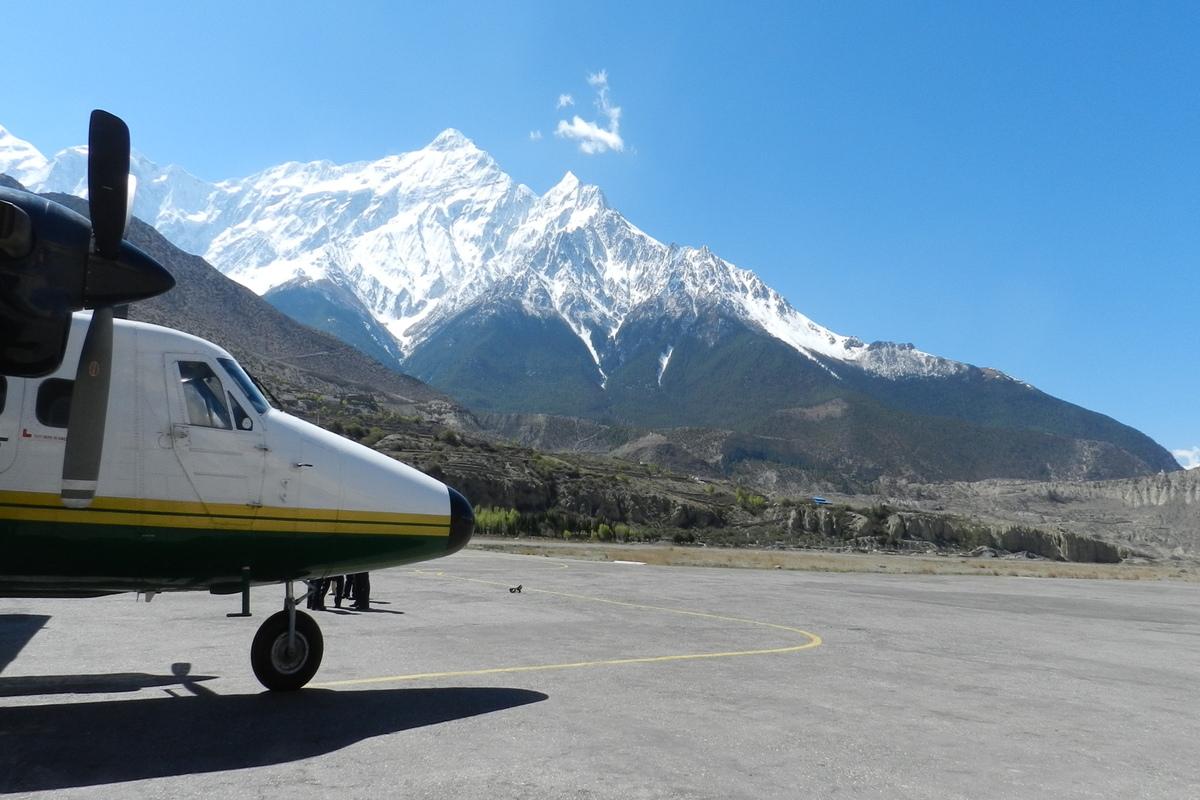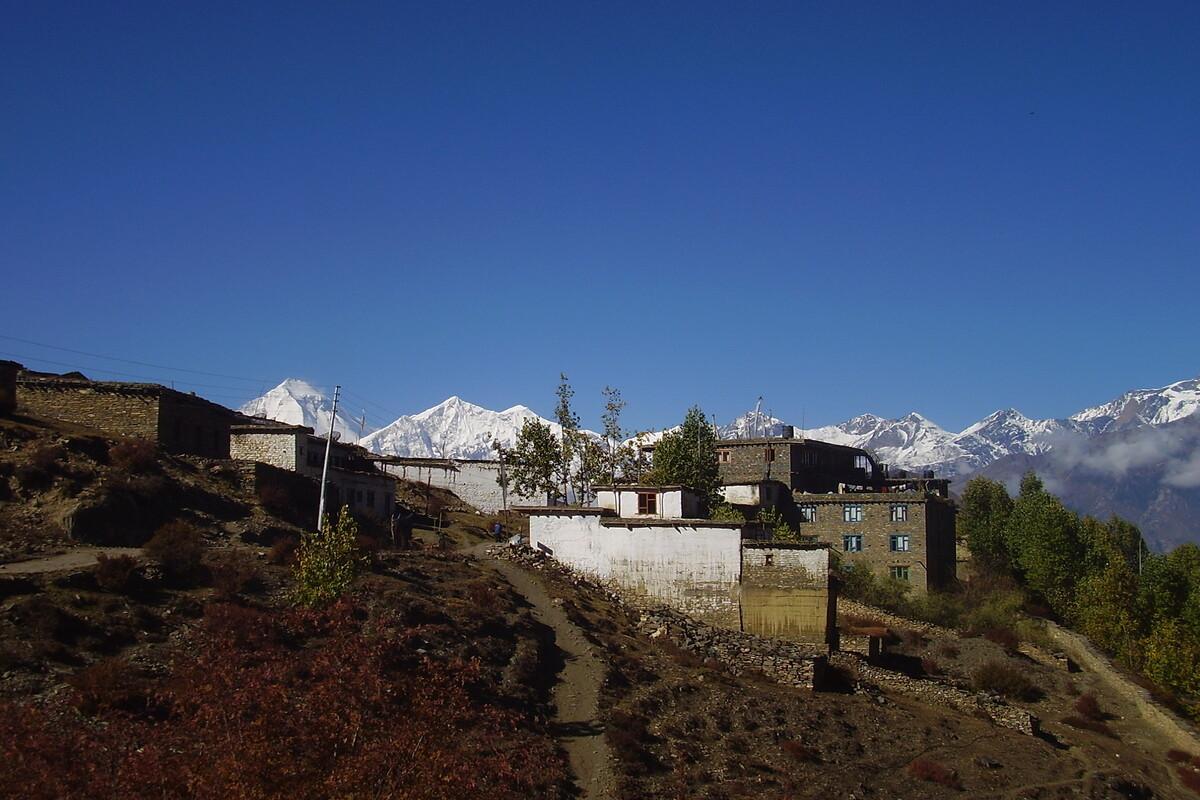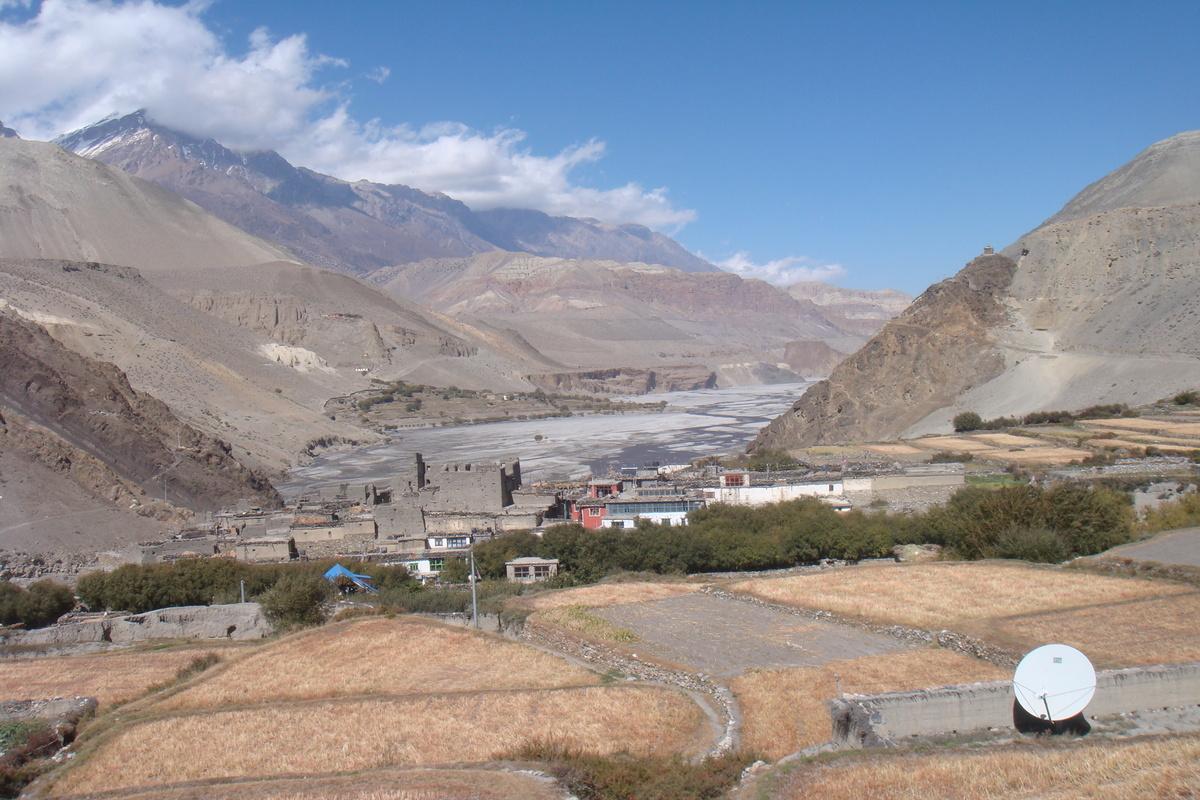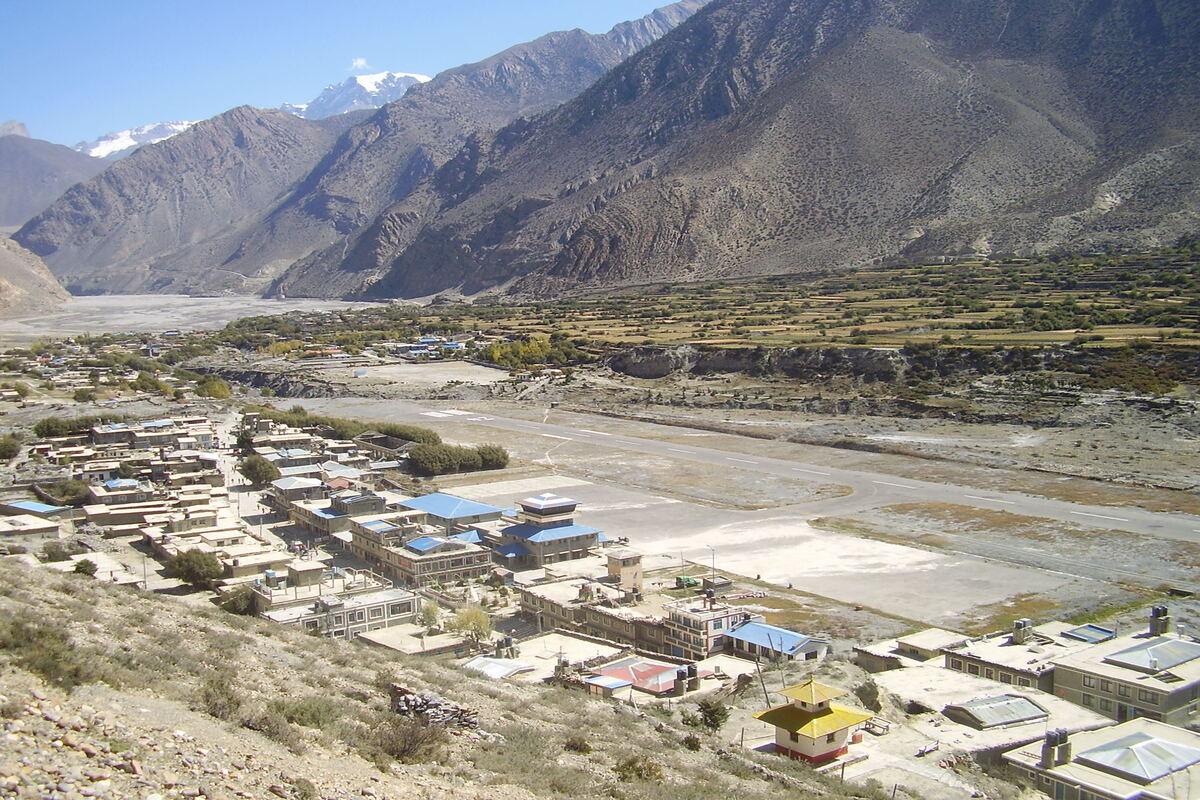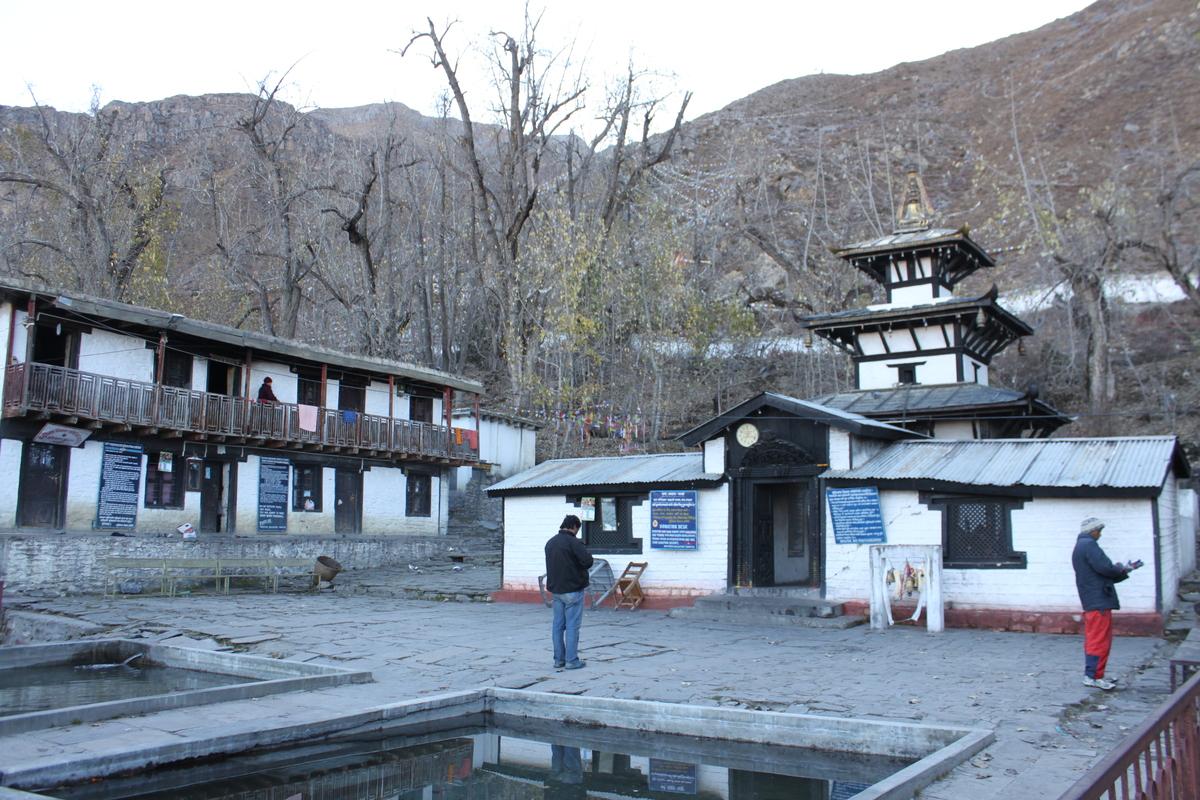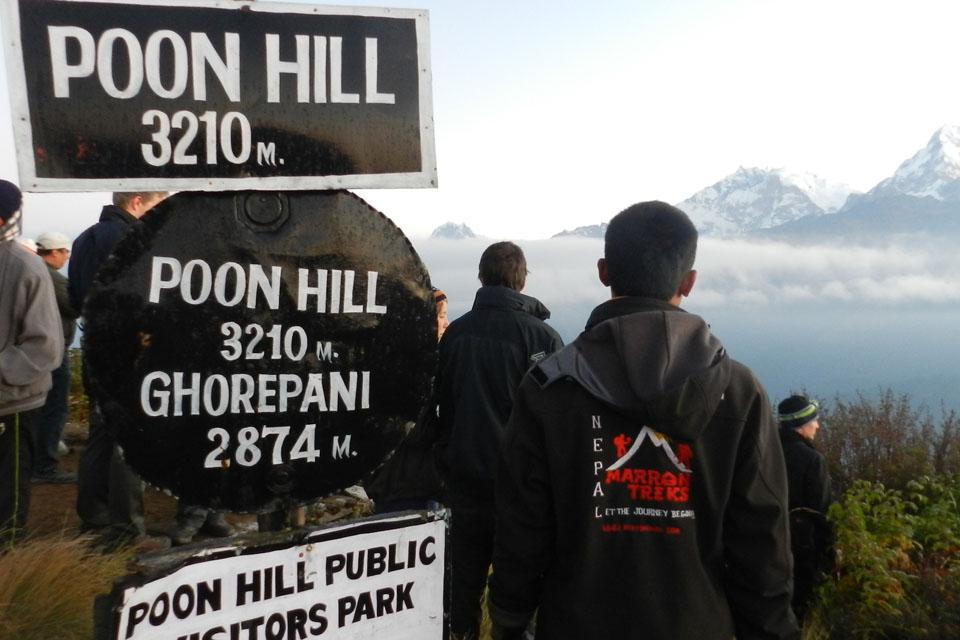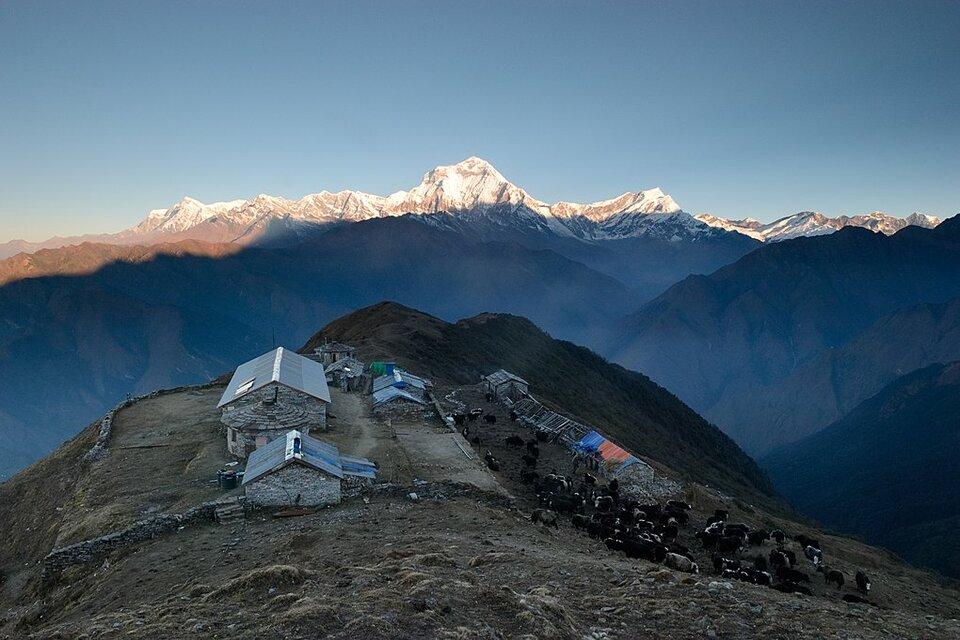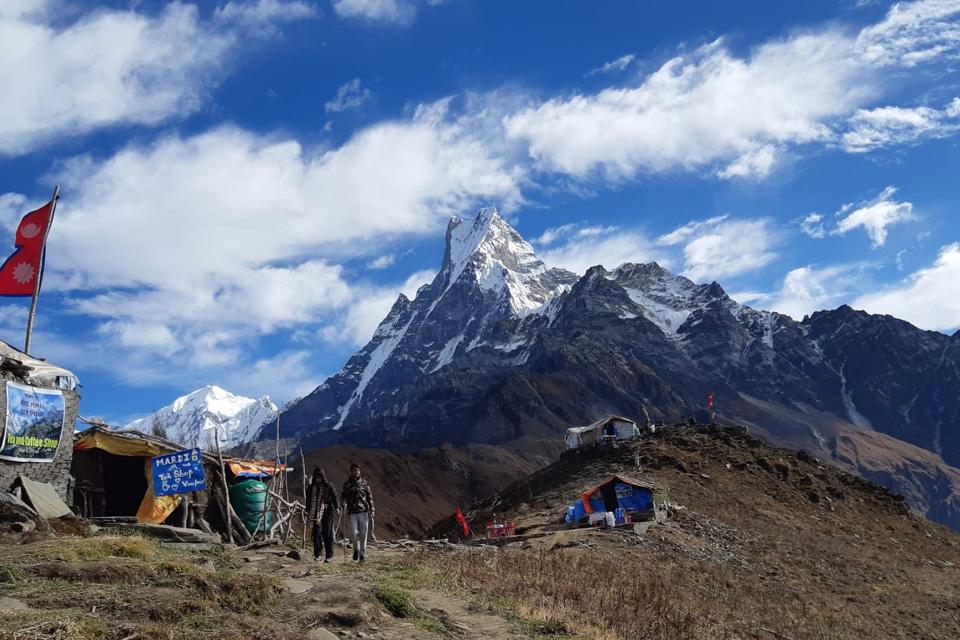Jomsom Muktinath Trek
Trip at a Glance
Jomsom Muktinath Trek is a cultural trek in the Lower Mustang region with panoramic views of the Himalayas and it’s surrounding unique landscapes. One gets to witness spectacular views of Mt. Annapurna throughout the trek where the trek provides adventure, spectacular views and witnessing the local culture.
A trek to Muktinath is a visit to the holy and cultural pilgrimage site of Muktinath both for Hindus and Buddhists. The trek route of Jomsom Muktinath is the classic route that goes along the world’s deepest gorge, the Kali Gandki River Gorge. Many beautiful mountain villages are scattered all over the trekking route making it un unforgettable journey in the Himalayas.
The trek starts after you take a scenic flight of about 20 minutes from Pokhara to Jomsom then start the trek to Kagbeni. Jomsom is the gateway to Mustang region and a popular tourist hub for trekkers starting or ending treks into the Mustang or Annapurna regions.
Jomsom Muktinath trek itinerary then takes you walking along the Kali Gandaki River valley towards the holy site of Muktinath. The trekking trail passes through charming villages, apple orchards, and barren landscapes observing spectacular snow-capped peaks. One thing you will notice is that the landscapes change from lush green valleys to barren desert-like terrain whilst on the trail making this trek a unique trekking experience in the Himalayas.
Upon reaching Muktinath, visit the famous temple of Muktinath which includes 108 water spouts and the holy pond where it’s believed that taking a dip will liberate your sins and bring salvation.
Jomsom Muktinath Trek is a rewarding trek with cultural immersion, amazing scenery, and a sense of spiritual fulfillment for anyone seeking a unique trekking experience in Nepal.
Jomsom Muktinath Trek Highlights
- A beautiful journey from Kathmandu to Pokhara.
- Take a scenic flight from Pokhara and Jomsom.
- Kali Gandaki River's deepest gorge in the world.
- Visit Muktinath Temple (3760m), the sacred Hindu & Buddhist pilgrimage site.
- Tatopani's natural hot springs.
- Poon Hill view point's sunrise mountain vista.
Itinerary
Day 01: Arrival in Kathmandu (1400m)
Day 02: Drive or fly from Kathmandu to Pokhara (5-6 hrs)
Day 03: Fly from Pokhara to Jomsom (2743m) & trek to Kagbeni (2804m/3-4 hrs)
Day 04: Trek from Kagbeni to Muktinath (3760m/3-4 hrs)
Day 05: Trek from Muktinath to Marpha (2750m/4-5 hrs)
Day 06: Trek from Marpha to Kalopani (2430m/5-6 hrs)
Day 07: Trek from Kalopani to Tatopani hot springs (1190m/6-7 hrs)
Day 08: Trek from Tatopani to Ghorepani (2850m/6-7 hrs)
Day 09: Hike to Poonhill (3210m) & trek to Nayapul then drive to Pokhara (822m/6-7 hrs walk /2 hrs drive)
Day 10: Drive or fly to Kathmandu from Pokhara
Day 11: Final departure
Arrive in Kathmandu and one of our representatives will receive you and then transfer to your hotel in Kathmandu. The rest of the time is free to explore the city where your hotel is located which is usually at Thamel – the popular tourist hub in Kathmandu where every needs and facilities for the tourist are located like hotels, pubs, restaurants, departmental stores, trek gear shops etc. Or you can simply rest at your hotel if you are jet lagged and get ready for an amazing Himalayan trek.
Early in the morning drive from Kathmandu to Pokhara in a tourist bus. The journey takes you through scenic landscapes, offering glimpses of rural life, terraced fields, and stunning views of the Himalayas (weather permitting). The drive is around 200 kilometers (125 miles) long and usually takes between 6 to 7 hours, depending on road conditions and traffic. You can also drive by a private vehicle.
The bus will finally arrive at the tourist bus park in Pokhara and you will check-in hotel in Pokhara. The rest of the time is rest at hotel or you are free to explore Pokahra if you wish.
Option: You can choose to either take a private vehicle for Kathmandu/Pokhara overland drive or fly to Pokhara from Kathmandu (25 minutes flight
Take an early morning flight from Pokhara to Jomsom. The flight offers spectacular views of the Himalayas, including Annapurna and Dhaulagiri ranges.Upon arrival in Jomsom, you’ll be welcomed by the dry and windy conditions characteristic of the Mustang region. Jomsom is a key administrative and commercial hub in the Mustang region. Upon reaching Jomsom, start the trek following the trail along the Kali Gandaki River, which offers stunning views of the river valley and the surrounding barren landscapes. After 3-4 hours of trek, Kagbeni is reached which is a picturesque village located at the junction of the Kali Gandaki and the Jhong Khola rivers. The village has traditional Tibetan-style houses and narrow alleys, and is a gateway to the Upper Mustang region.
Start early from Kagbeni enjoying the views of the Kali Gandaki River and the barren landscapes that characterize the region. The trail involves a gradual ascent, passing through a series of small villages and arid landscapes typical of the Mustang region. En route, you'll be treated to panoramic views of the Dhaulagiri and Nilgiri mountain ranges. Finally arrive Muktinath which is a sacred pilgrimage site for both Hindus and Buddhists. The temple complex includes a Vishnu temple and a Buddhist monastery, symbolizing religious harmony. Enjoy the serene atmosphere and the 108 water spouts, where pilgrims take ritual baths.
Today the trail involves a steady descent, moving from the higher altitudes of Muktinath down to the lower regions. You will pass through small villages, terraced fields, and apple orchards, characteristic of the region. Enjoy the changing landscapes as you descend, with the arid terrain giving way to greener pastures. The trail provides beautiful views of the Nilgiri and Dhaulagiri mountain ranges. Soon Marpha is reached which is a charming village known for its whitewashed houses, narrow alleys, and apple orchards. It is famous for its apple products, including apple brandy and dried apples.
After breakfast, being the trek where the trail today involves a mix of gradual descents and some flat sections. You wil have to cross the Kali Gandaki River via suspension bridges, providing great photo opportunities and walking through pine and rhododendron forests, enjoying the changing scenery. The route offers stunning views of Dhaulagiri, Tukuche Peak, and the Annapurna range. Kalopani is a small village set against the backdrop of majestic snow-capped peaks. The village offers a serene environment and panoramic mountain views.
Today you will go for a significant descent, moving from higher altitudes down to the lower elevations of Tatopani. You will walk through dense forests, terraced fields, and charming villages and cross several suspension bridges over the Kali Gandaki River, offering stunning views. Reach Tatopani which is popular for its natural hot springs, a perfect place to relax after a long day's trek. Enjoy a rejuvenating soak in the hot springs, believed to have therapeutic properties.
The trail today moves through lush forests and terraced fields, gradually changing as you climb. You will hike through dense rhododendron and pine forests, with occasional views of waterfalls and streams. Ghorepani is a popular trekking destination with stunning views of the Annapurna and Dhaulagiri ranges. The village is popular for its panoramic sunrise view from Poon Hill, which you can explore the next day.
Start your hike to Poon Hill early in the morning to catch the sunrise. It’s a steep but short climb, usually taking about 45 minutes to an hour. Poon Hill offers one of the best sunrise views in the Annapurna region. Enjoy breathtaking panoramic views of the Annapurna and Dhaulagiri ranges as the sun rises, casting golden hues over the snow-capped peaks. After enjoying the sunrise, return to Ghorepani for breakfast and to prepare for the trek to Nayapul where the descent is gradual and involves a mix of forested trails and terraced fields. From Nayapul, you'll drive to Pokhara and rest/relax at hotel in Pokhara.
After breakfast, drive to Kathmandu from Pokhara by a tourist bus retracing the same highway route which you took earlier. Upon reaching Kathmandu, check-in hotel and the rest of the time is free to explore or rest. In the evening is Farewell Dinner at one of the authentic Nepali Restaurant with a cultural show.You can also drive by a private vehicle.
Option: You can choose to either take a private vehicle for Pokhara/Kathmandu overland drive or fly to Kathmandu from Pokhara (25 minutes flight)
The trip concludes and our office representatives will take you to the international airport in Kathmandu to catch your onward flight to your next destination or fly back home. You need to be at least 3 hours prior to your flight time at the airport.
Thank you for visiting Nepal and we hope your Himalayan Holiday has come true. Have a safe flight back home!
What is included?
- Airport pick-up and drop services.
- Hotel accommodations in Kathmandu & Pokhara with breakfast.
- Kathmandu/Pokhara/Kathmandu transfers by a tourist bus (Option: Private vehicle/Flight)
- All trekking accommodations with Breakfast/Lunch/Dinner at local lodges.
- Four seasonal sleeping bags (to be returned after trip completion) & Marron Treks duffel bag,
- Nayapul/Pokhara transfers by private vehicle.
- A comprehensive medical kit (will be carried by the trekking guide)
- Experienced Government licensed English Speaking Guide & Porter (1 porter for two people) including their food, accommodation, salary & insurance.
- Pokhara to Jomsom flight fare.
- Permits for Annapurna Conservation Area and TIMS (Trekkers' Information Management System)
- Farewell Dinner at Nepali Authentic Restaurant with cultural program.
- All government and local taxes.
What is not included?
- International airfare
- Nepal entry visa fee – Visa can be obtained upon your arrival at the Tribhuwan International Airport in Kathmandu. (USD30 for 15 days)
- Lunch & dinner in Kathmandu or Pokhara.
- Personal travel insurance.
- Emergency rescue evacuation (to be covered by the client's travel insurance).
- Other expenses of a personal nature (phone calls, laundry, battery recharge, extra porters, bottle or boiled water, hot shower etc.)
- Personal trekking gear and equipment
- Bar bills, alcoholic drinks & beverages.
- Tips for guides and porters (Tipping is expected).
Route Map
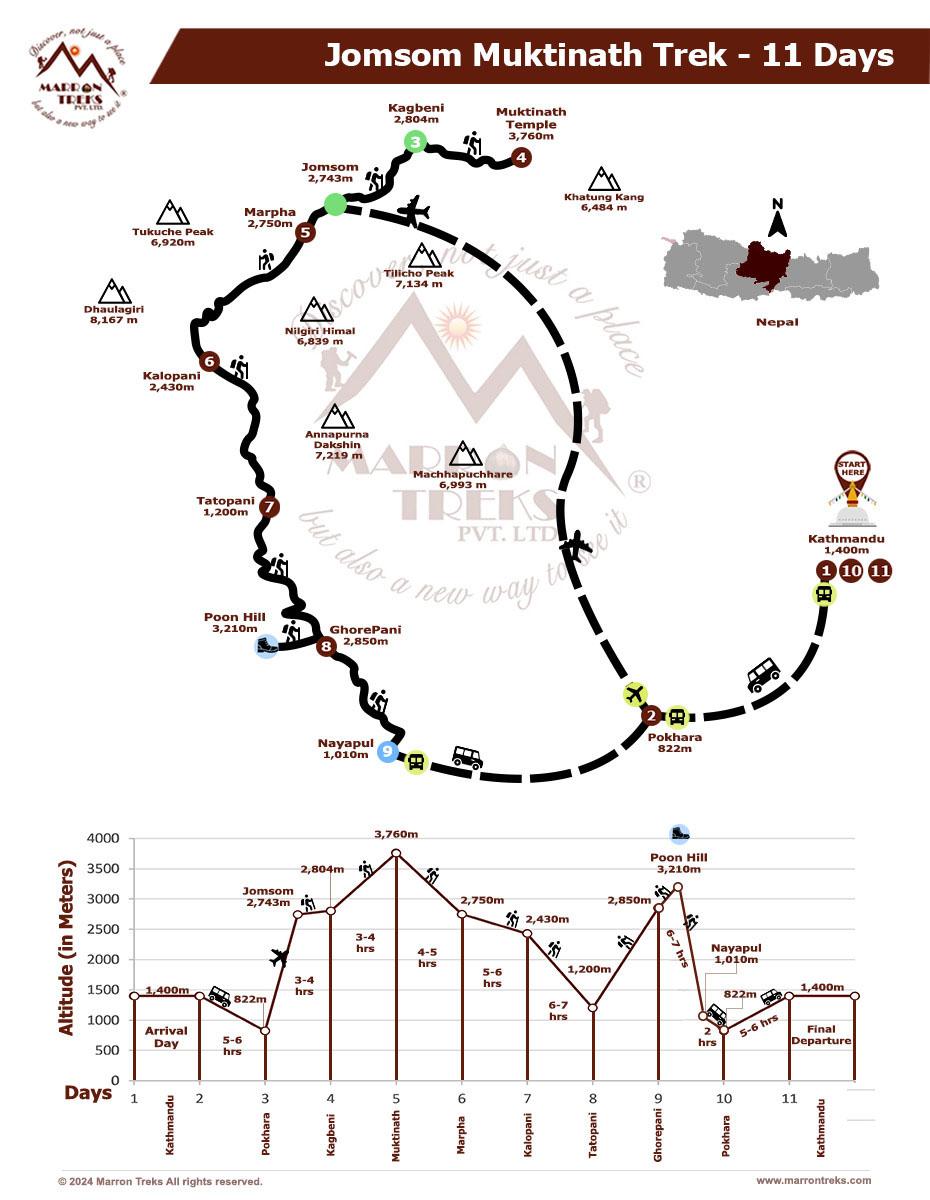
Trip Info
Accommodation
While you are in Kathmandu, we opt to accommodate you in 4- or 5-star hotels like Hotel Royal Singhi (4-star), Hotel Manaslu (4-star), Radisson (5-star), Yak & Yeti (5-star), or similar. During the trek, you will be accommodated in a local mountain lodge, better known as Tea House. These lodges and teahouses provide good services and are equipped with basic amenities. We will endeavor to provide you with the best accommodation available along the route so that you get a good night’s rest in a hygienic milieu.
Meals
We never compromise the quality of food or the health of the trekkers as well as the crew members. Generally, we opt for the fresh and nutritional local community food available. You could make your delicious pick from an array of traditional foods like Sweet potatoes, buckwheat barley, etc. This way, you could not only get a real sense of the local culture and life patterns but also contribute to promoting the locally available resources of organic food and beverages. Besides, a wide range of Continental, Chinese, Italian and Indian cuisines like Pizza, Spaghetti, French Fries, Soups, Breads, Masala curry, etc. are also available in the restaurants for your retreat.
Acclimatization
Altitude sickness is a serious risk while trekking in the Himalayas. It's important to acclimatize properly by spending a few days at lower altitudes before heading higher. By spending time at lower altitudes before pushing higher, your body has time to adjust. Our trekking packages have enough acclimatization days planned where you'll be spending a day or two at lower altitudes, allowing your body to adjust to the increasing altitude.
Electricity & drinking water
For an additional cost, you can use the electricity in all tea houses and lodges to recharge your batteries. The lodges have packaged mineral water for sale, or you can fill your bottle with boiling water. To make water drinkable, you can use water purification tablets too. But, due to hygienic issues, you should avoid drinking water from taps, rivers, or wells in trekking areas.
Communication
At lodges, restaurants, and hotels, Wi-Fi is available for an additional fee in the most popular trek regions, like Everest, and Annapurna. However, at high elevations, phone calls are the only means of connection. Our office in Kathmandu is in constant communication with your trek guide. In Kathmandu, you can purchase a local sim card for communication purposes. At high elevations, the mobile signal might not be as strong, though.
Luggage
Our porters are paired with one trekker for every two hikers, and one porter can safely carry 30 kg maximum weight. Therefore, we advise you to fill your duffle bag not more than 15 kg with your belongings. You may carry a small backpack with your valuables and informational documents. The things you are not taking along on the trek can be stored in a hotel in Kathmandu free of cost.
Typical Trek Day
Mostly your trek day starts with breakfast at 7-8 am, followed by a 3-4 hour morning trek. Lunch break is around an hour, then you continue trekking to your destination for the day. After reaching the teahouse lodge, you can relax, explore nearby areas, and enjoy dinner at 6-7 pm. Evenings involve socializing, a trek briefing, and leisure activities before bed.
Travel Insurance
It is advised that you arrange your travel insurance before leaving your homeland. The main thing is to make sure that your insurance covers you for both- medical and evacuation costs. Having travel insurance with you makes your trip secure and hassle-free.
Our Guides
Guides play a significant role during the trek. They are the ones who literally decipher the trekking codes for you so that you can actually connect with nature, culture and people along the way. We have helpful and dedicated trekking guides who are very well-versed in the culture, life patterns and every single detail pertaining to the trek region you are traveling in. Thus, in the company of our professional Sherpa guides, your trek becomes not only entertaining but also equally informative.
Porter and Staff Care
When it comes to high-altitude trekking, porters and staff members make up a pivot. Marron Treks ensures that all the porters and staff members going to high altitudes are provided with adequate clothing and equipment. All our field staff are covered by insurance.
